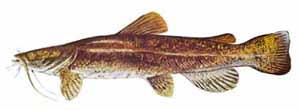Flathead Catfish (Pylodictis olivaris)
- Other Names
- Yellow Cat, Opelousa Cat, Pied Cat, Mississippi Cat, Mud Cat, Shovelhead Cat
- Description
- Game fish - see statewide bag & size limits and lake-specific exceptions
As the common name suggests, this catfish has a flat head, but other than that, it looks like any other catfish: it has smooth, scaleless skin, whisker-like barbels around the mouth, and long spines on the dorsal (back) fin and one on each side of the pectoral (shoulder) fin. Flathead catfish reach a length of 3 to 4 feet (0.9 to 1.2 m) and their weight can exceed 100 pounds (45 kg). Pylodictis is Greek meaning "mud fish", and olivaris is Latin for "olive-colored". Flathead catfish are typically pale yellow (hence the name "yellow cat") to light brown on the back and sides, and highly mottled with black and/or brown. The belly is usually pale yellow or cream colored. The head is broadly flattened, with a projecting lower jaw. The tail fin is only slightly notched, not deeply forked as is the case with blue and channel catfish. Young fish may be very dark, almost black in appearance. - Life History
- Unlike other catfish which are scavengers, flatheads prey only on live fish. Young flathead catfish feed mostly on invertebrates such as worms, insects and crayfish. When 10 inches or larger, their diet consists entirely of fish: shad, carp, suckers, sunfish, largemouth bass and other catfish (including their own kind). Flathead catfish are eaten by alligators, water snakes, turtles, larger fish, and humans. They reach sexual maturity between the third and sixth year. Spawning season is from late May through August, when the water temperature is between 75° and 80° F.
Males select hollow logs, caves or areas beneath the banks for their nest sites. Males may even improve their selected sites by creating shallow depressions for the females to lay their eggs. Egg number varies greatly depending on female size, but the average is up to 100,000 eggs at a time. Scientists estimate that a female will lay 1200 eggs for every pound she weighs. A female flathead that weights 50 pounds might release 60,000 eggs at a time. After an incubation period of four to six days, the fry (very young fish) will school together at the nest for several days after hatching; afterwards they will seek shelter beneath rocks, roots and other cover and begin their independent lives. Average lifespan of the flathead catfish is 12 to 14 years, but one recorded flathead catfish lived 24 years.
Adults are usually solitary, each staking out a favorite spot under a tree or in a cove, in deep water. At night, they move into shallow areas to feed. Males defend their nest and eggs aggressively. They will fan the nest with their tails to keep the eggs clean and provide them with oxygenated water. If females have been eating poorly, their bodies may conserve resources by not releasing eggs. Poor overall health and certain environmental conditions such as drought or flood can reduce flatheads' ability to spawn. In healthy times, clutches can reach 100,000 eggs, but only a small number will survive. - Habitat
- Flathead catfish prefer deep pools of streams, rivers, canals, lakes and reservoirs, where the water is turbid (cloudy) and the currents are slow.
- Distribution
- Flathead catfish range from the lower Great Lakes through the Mississippi River watershed to the Gulf states.
- Other
In size, flatheads are the second largest sport fish in Texas after their cousin, the blue catfish. "Catfish" is the second most preferred group of fish among licensed Texas anglers, and flatheads rank second behind channel catfish. Where mature populations exist, 50-pounders are not unusual. Typically, the largest fish are caught by trotliners, who have landed specimens in excess of 110 pounds. Rod and reel anglers may have the greatest success with flathead catfish just below reservoir dams. Because of their popularity with anglers, they have been introduced in many other states where they have adapted well. In some cases, however, they have out-competed the native fish species, causing those native fish populations to decline sharply, disrupting some natural ecological processes.
